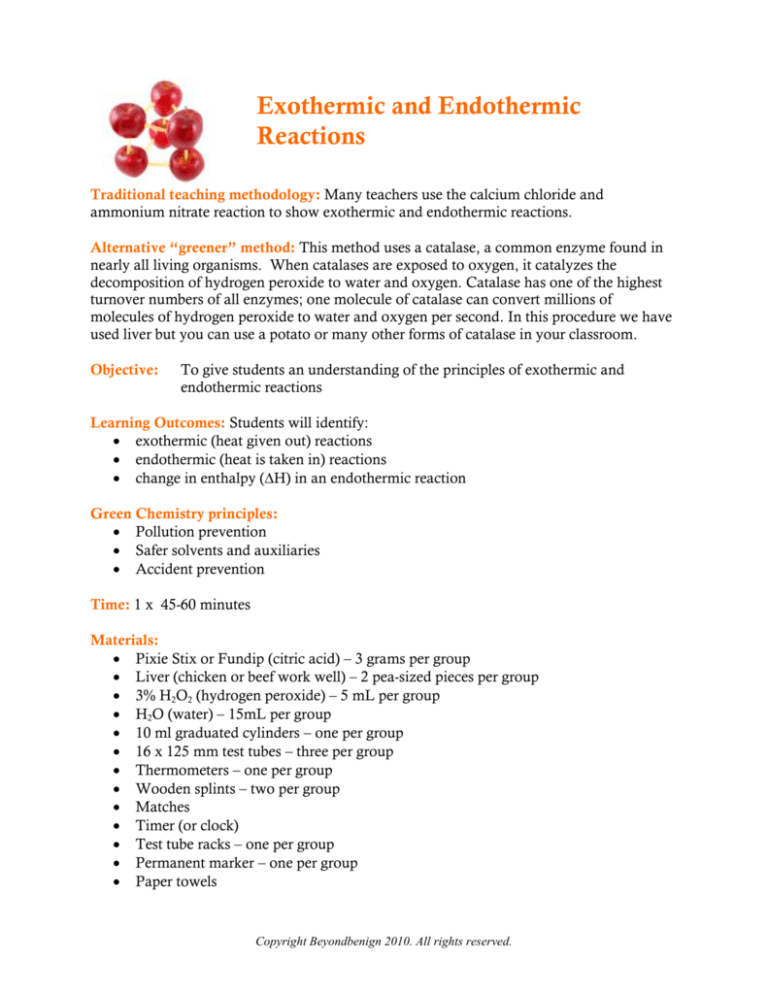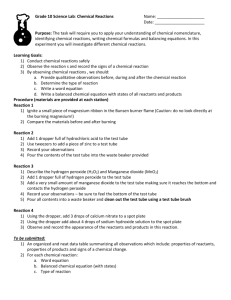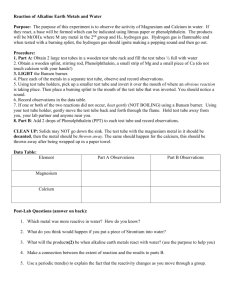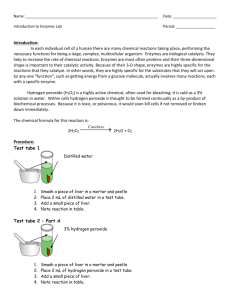
Exothermic and Endothermic
Reactions
Traditional teaching methodology: Many teachers use the calcium chloride and
ammonium nitrate reaction to show exothermic and endothermic reactions.
Alternative “greener” method: This method uses a catalase, a common enzyme found in
nearly all living organisms. When catalases are exposed to oxygen, it catalyzes the
decomposition of hydrogen peroxide to water and oxygen. Catalase has one of the highest
turnover numbers of all enzymes; one molecule of catalase can convert millions of
molecules of hydrogen peroxide to water and oxygen per second. In this procedure we have
used liver but you can use a potato or many other forms of catalase in your classroom.
Objective:
To give students an understanding of the principles of exothermic and
endothermic reactions
Learning Outcomes: Students will identify:
exothermic (heat given out) reactions
endothermic (heat is taken in) reactions
change in enthalpy (∆H) in an endothermic reaction
Green Chemistry principles:
Pollution prevention
Safer solvents and auxiliaries
Accident prevention
Time: 1 x 45-60 minutes
Materials:
Pixie Stix or Fundip (citric acid) – 3 grams per group
Liver (chicken or beef work well) – 2 pea-sized pieces per group
3% H2O2 (hydrogen peroxide) – 5 mL per group
H2O (water) – 15mL per group
10 ml graduated cylinders – one per group
16 x 125 mm test tubes – three per group
Thermometers – one per group
Wooden splints – two per group
Matches
Timer (or clock)
Test tube racks – one per group
Permanent marker – one per group
Paper towels
Copyright Beyondbenign 2010. All rights reserved.
Teacher Prep:
1. Wearing gloves, tear liver into pea-sized pieces. Prepare enough liver for entire class.
2. Set out all materials for student access.
3. Write the guiding questions on the board for each of the lab activities.
o Lab 1: How does temperature change during the process of hydrogen
peroxide decomposition?
o Lab 2: How does the temperature change during the process of citric acid
reacting with water?
Copyright Beyondbenign 2010. All rights reserved.
Exothermic and Endothermic Reactions
Student Lab Sheet
Part 1 – Decomposition of hydrogen peroxide
Follow the procedure listed below and complete the data tables.
Collect the following materials:
2 pea-sized liver pieces
5 ml H2O2 (hydrogen peroxide)
5 ml H2O (water)
2 test tubes (16 x 125mm tubes)
Test tube rack
10 ml graduated cylinder
Thermometer
2 wooden splints
Matches
Timer (or clock)
Permanent marker
Paper towel
Procedure:
1. Label 2 test tubes A and B with a permanent marker and place in test tube rack.
2. Using the 10 ml graduated cylinder, measure 5 ml of H2O (water) and pour it into test
tube A.
3. Using the 10 ml graduated cylinder, measure 5 ml of H2O2 (hydrogen peroxide) and
pour it into test tube B.
4. Place a thermometer into test tube A.
5. Record test tube A’s starting temperature into Data table I.
6. Add one piece of liver to test tube A.
7. One partner should record the temperature at 30 second intervals in Data Table II for 3
minutes. Another partner should carefully lower a glowing splint into test tube A right
after adding the liver in, and record observations into data table I.
(Note: Glowing splint light a splint with a match, make sure an orange glow is visible, then
blow the flame out. Make sure the wooden splint is glowing before lowering it into test tube.)
8. Record all observations for test tube A in Data Table I.
9. Record ending temperature in Data table I.
10. Wipe the thermometer clean with a paper towel and place it into test tube B.
11. Record test tube B’s starting temperature into Data table I.
12. Add one piece of liver into test tube B.
Copyright Beyondbenign 2010. All rights reserved.
13. One partner should record the temperature at 30 second intervals in Data Table II for 3
minutes. Another partner should carefully lower a glowing splint into test tube B right
after adding the liver in, and record observations into data table I.
14. Record all observations for test tube B in data table I.
15. Record end temperature in Data table I.
16. Carefully lower a glowing splint into test tube B and record observations into data
table I.
17. Clean up and return all materials (materials are non-hazardous, solids can be discarded
in the trash and liquids in the sink.)
Data and Observations:
Data Table I
Starting
temperature in
°C
Observations
after adding liver
Ending
temperature in
°C
Glowing splint
results
Test tube A
H2O
Test Tube B
H2O2
Data Table II
Starting
temperature
in ˚C
30 sec.
60 sec.
90 sec.
120 sec.
Test tube A
H2O
Test Tube B
H2O2
Starting temperature with water:
_______________ ˚C
Ending temperature with water:
_______________ ˚C
Starting temperature with hydrogen peroxide:
_______________ ˚C
Ending temperature with hydrogen peroxide:
_______________ ˚C
Copyright Beyondbenign 2010. All rights reserved.
150 sec.
180 sec.
Questions for Part 1:
1. Did an exothermic or endothermic reaction occur in test tube A? How do you
know?
2. Did an exothermic or endothermic reaction occur in text tube B? How do you
know?
3. Explain how temperature changes during the process of decomposing hydrogen
peroxide.
Copyright Beyondbenign 2010. All rights reserved.
Part 2 – Citric acid and water
Follow the procedure listed below and complete the data tables.
Collect the following materials:
1 test tube (16 x 125mm test tubes or larger work well)
Test tube rack
3 grams of Pixie Stix or Fundip
Thermometer
10 ml water (room temperature)
10 ml graduated cylinder
Procedure:
1. Using a 10 ml graduated cylinder, measure 10 ml water and pour it into a test tube.
2. Place the test tube in the test tube rack.
3. Place a thermometer into the water and record the starting temperature in Data table
III.
4. Quickly add all of the candy. The candy does not need to fully dissolve in the water.
5. Record temperature change at 10 second intervals for 60 seconds, then at 30 second
intervals until 180 seconds is reached in data table III.
6. Record ending temperature.
7. Clean up and return all materials (materials are non-hazardous, solids can be
discarded in the trash and liquids in the sink.)
Data and Observations:
Data Table III
Starting
Temp
10
sec.
20
sec.
30
sec.
40
sec.
50
sec.
60
sec.
Water
temperature
°C
Starting temperature:
_______________ ˚C
Ending temperature:
_______________ ˚C
Copyright Beyondbenign 2010. All rights reserved.
90
sec.
120
sec.
150
sec.
180
sec.
Questions:
1. Did an exothermic or endothermic reaction occur in the test tube? How do you
know?
2. Explain how the temperature changes during the process of citric acid reacting
with water?
Conclusion:
Define Exothermic and Endothermic reactions and describe how this experiment
demonstrates one or both of these terms.
Copyright Beyondbenign 2010. All rights reserved.
Exothermic and Endothermic Reactions
Student Lab Sheet – Teacher Key
Part 1 – Decomposition of hydrogen peroxide
Follow the procedure listed below and complete the data tables.
Collect the following materials:
2 pea-sized liver pieces
5 ml H2O2 (hydrogen peroxide)
5 ml H2O (water)
2 test tubes (16 x 125mm tubes)
Test tube rack
10 ml graduated cylinder
Thermometer
2 wooden splints
Matches
Timer (or clock)
Permanent marker
Procedure:
1. Label 2 test tubes A and B with a permanent marker and place in test tube rack.
2. Using the 10 ml graduated cylinder, measure 5 ml of H2O (water) and pour it into test
tube A.
3. Using the 10 ml graduated cylinder, measure 5 ml of H2O2 (hydrogen peroxide) and
pour it into test tube B.
4. Place a thermometer into test tube A.
5. Record test tube A’s starting temperature into Data table I.
6. Add one piece of liver to test tube A.
7. One partner should record the temperature at 30 second intervals in Data Table II for 3
minutes. Another partner should carefully lower a glowing splint into test tube A right
after adding the liver in, and record observations into data table I.
(Note: Glowing splint light a splint with a match, make sure an orange glow is visible, then
blow the flame out. Make sure the wooden splint is glowing before lowering it into test tube.)
8. Record all observations for test tube A in Data Table I.
9. Record ending temperature in Data table I.
10. Wipe the thermometer clean with a paper towel and place it into test tube B.
11. Record test tube B’s starting temperature into Data table I.
12. Add one piece of liver into test tube B.
Copyright Beyondbenign 2010. All rights reserved.
13. One partner should record the temperature at 30 second intervals in Data Table II for 3
minutes. Another partner should carefully lower a glowing splint into test tube B right
after adding the liver in, and record observations into data table I.
14. Record all observations for test tube B in data table I.
15. Record end temperature in Data table I.
16. Carefully lower a glowing splint into test tube B and record observations into data table I.
17. Clean up and return all materials (materials are non-hazardous, solids can be discarded in
the trash and liquids in the sink.)
Data and Observations:
Data Table I
Starting
temperatures in °C
22
Observations after
adding liver
No changes
observed
Bubbling/foaming
observed
Test tube A
22
Test Tube B
Ending
temperatures in °C
23
28
Glowing splint
results
Splint does not
relight
Wooden splint
relights
Data Table II
Test tube A
Test tube B
Starting
30 sec.
Temperature in
˚C
23
23
23
24
60 sec.
90 sec.
120 sec.
23
23
23
23
23
25
26
26
27
28
Starting temperature with water:
______23_______ ˚C
Ending temperature with water:
______23_______ ˚C
Starting temperature with hydrogen peroxide:
______23_______ ˚C
Ending temperature with hydrogen peroxide:
______28_______ ˚C
Copyright Beyondbenign 2010. All rights reserved.
150 sec.
180 sec.
Questions:
1. Did an exothermic or endothermic reaction occur in test tube A? How do you know?
Neither. The temperature did not change. No reaction occurred, no changes were
observed in the test tube.
2. Did an exothermic or endothermic reaction occur in text tube B? How do you know?
An exothermic reaction occurred. The temperature increased from 23˚C to 28˚C in 3
minutes.
3. Explain how temperature changes during the process of decomposing hydrogen peroxide.
The temperature increases during the process of breaking down hydrogen peroxide. As
hydrogen peroxide is introduced to the catalase, an exothermic reaction occurs in which
heat is given off, resulting in the formation of water and oxygen.
Copyright Beyondbenign 2010. All rights reserved.
Part 2 – Citric acid and water
Follow the procedure listed below and complete the data tables.
Collect the following materials:
1 test tube (16 x 125mm test tubes or larger work well)
Test tube rack
3 grams of Pixie Stix or Fundip
Thermometer
10 ml water (room temperature)
10 ml graduated cylinder
Procedure:
1.
2.
3.
4.
5.
6.
7.
Using a 10 ml graduated cylinder, measure 10 ml water and pour it into a test tube.
Place the test tube in the test tube rack.
Place a thermometer into the water and record the starting temperature in Data table
III.
Quickly add all of the candy. The candy does not need to fully dissolve in the water.
Record temperature change at 30 second intervals in data table III for 3 minutes.
Record ending temperature.
Clean up and return all materials (materials are non-hazardous, solids can be
discarded in the trash and liquids in the sink.)
Data and Observations:
Data Table III
Initial
Temp (˚C)
Water
temperature
°C
23˚C
10
sec.
20
sec.
30
sec.
40
sec.
50
sec.
60
sec.
90
sec.
120
sec.
150
sec.
180
sec.
18˚C
18˚C
18˚C
18˚C
18˚C
18˚C
18˚C
18˚C
18˚C
18˚C
Starting temperature:
______22_______ ˚C
Ending temperature:
______18_______ ˚C
Copyright Beyondbenign 2010. All rights reserved.
Questions:
1. Did an exothermic or endothermic reaction occur in the test tube? How do you know?
An endothermic reaction occurred. The water temperature decreased over time, and the
test tube felt cold. This means that heat was absorbed into the test tube.
2. Explain how the temperature changes during the process of citric acid reacting with water?
The temperature quickly decreased from 21˚C to 23˚C in 30 seconds. Over the next 2.5
minutes, the temperature gradually increased and stabilized at 18˚C, but it never reaches
its original temperature of 21˚C. When citric acid is added to water, an endothermic
reaction occurs in which heat is absorbed into the system.
Conclusion:
Define Exothermic and Endothermic reactions and describe how this experiment demonstrates
one or both of these terms.
Exothermic reaction – a chemical reaction that involves the release of energy
Endothermic reaction – a chemical reaction that involves the addition of energy
In part 1 of this experiment, the addition of the liver’s proteins to the hydrogen peroxide
resulted in an increased solution temperature. Since heat was released, this demonstrated
an exothermic reaction.
In part 2 of this experiment, the addition of the candy (consisting of citric acid) resulted
in a decreased solution temperature. Since heat was absorbed into the system, the
solution got cooler, and this demonstrated an endothermic reaction.
Copyright Beyondbenign 2010. All rights reserved.







